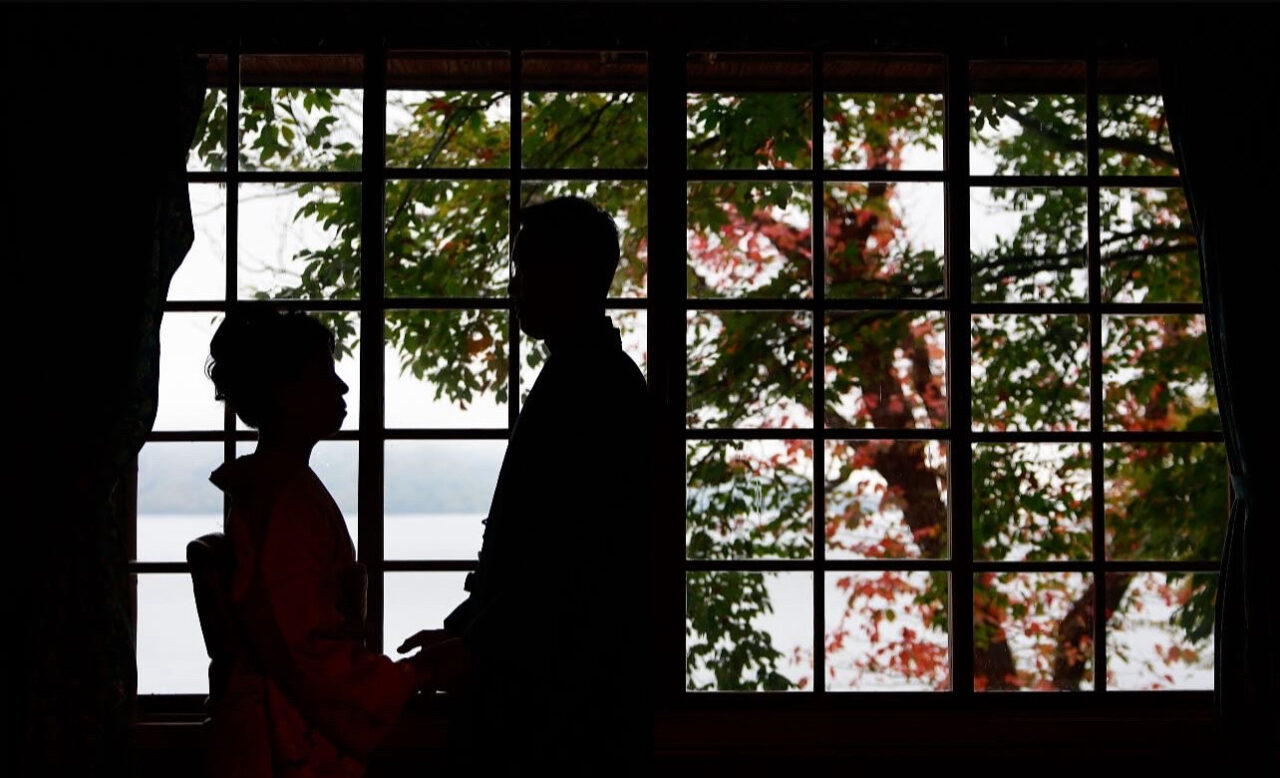The Aesthetics of Silhouette and Shadow:
Photographs that Capture the Beauty of Light and Shade — The World of “Shadow Pictures” ~ Discovering the Charm of Nikko
【Nikko is beautiful, Kimono is beautiful】
それは、日本の伝統的な「引き算の美学」、「余白の美」そのものに通じる、究極の美意識。
「着物や髪型や景色の美しさは、必ずしも鮮やかさに表現しなくとも、シルエットで充分にその美しさを表現できる!」
鮮やかさだけでなく、影と輪郭が語る美の世界をお楽しみください。
着物という衣装を身にまとうことは、いつもの景色をまるで特別な舞台のセットに変える魔法です。この旅は、単なる観光ではありません。それは、日本の歴史と文化への敬意を払いながら、自分自身の美意識を再発見し、五感で「唯一無二の時間」を体感する旅なのです。
シルエット/陰影の美学:「影絵の世界観」を表現する陰影が美しい写真

多角的に「美」を捉える唯一無二の時間
着物で日光を巡る時間は、単に見て楽しむ観光ではありません。それは、五感のすべてを研ぎ澄まし、特別な時間を記録する「多角的な体験」であり、「内なる自己を写し、体感する時間」です。
(1) 多角的に写す:内面と魂の輝きを切り取る写真術
着物姿を写真に収めることは、日光の美しさを永遠の記録として残す作業ですが、それ以上の意味を持ちます。
それは、「鏡を見ただけでは決してわからない、内面、魂の輝きを写し取る」という、極めて詩的で深い行為です。
• 着物が内面を映す鏡となる:
着物は、姿勢や歩き方を正し、着る人の内にある「優雅さ」「凛々しさ」を強制的に引き出します。日光という神聖な場所で、その和の美しさを纏うことで、普段隠れている自己の精神性が外の世界に投影されます。写真家は、その引き出された「内なる美」を切り取るのです。
• シルエットと余白の美:引き算の芸術
着物姿の美しさは、色彩の鮮やかさだけでなく、その優美な輪郭(シルエット)と、それを包む空間の静寂によって、十二分に表現されます。
• シルエットの強調: 撮影時にあえて背景の明るさに露光を合わせ、着物姿を深い影として表現します。これにより、着物のなだらかな曲線や、アップに結った髪型の洗練された輪郭だけが際立ちます。夜明け前や夕焼け時の空、または雪景色の白い背景は、この「引き算の美」を表現する最高のキャンバスです。
• 「余白の美」の活用: 壮大な杉並木や中禅寺湖の広大な水面の中に、あえて着物姿を小さく配置します。この「余白」が、写真に奥行きと静寂をもたらし、「その場に流れる時間のゆとり」や「着物姿の持つ静かな存在感」といった、内面的な物語を見る者に感じさせます。
• 陰影の美学:「影絵の世界観」を表現する陰影が美しい写真
日光の歴史的建造物や深い森は、日本の美意識である「陰影礼賛」を体現する最高の舞台です。着物と日光の光が作り出す影(陰影)は、写真に奥行きと静謐なドラマを与え、まるで影絵のような幻想的な世界観を表現します。
• 杉並木の陰影: 樹齢数百年の杉並木の間に差し込む光が地面に落とす影は、まるで着物の柄のように複雑で美しい幾何学模様を作り出します。着物姿の足元や背中にその影を重ねることで、写真に深みと歴史の重みが加わります。特に、朝日の斜光を利用すると、よりドラマチックな影が生まれます。
• 御用邸の障子と光: 旧田母沢御用邸のような場所の障子や広縁では、柔らかい光が障子を通して差し込みます。その光の中に立つと、着物の輪郭が強調され、まるで影絵のような、静かで情緒的な一枚が完成します。「影を主役にする」ことで、その場の空気感が濃密に伝わります。また、あえて顔に影を落とし、表情の奥行きを表現するのも一興です。
• 建造物の影: 東照宮の荘厳な建物の影が地面や壁に落ちる瞬間を捉え、着物姿をその「影の中」に配置する構図は、歴史の重みと個人の存在感とを対比させ、見る者に強い印象を与えます。
• 光の魔法:
• 逆光の活用: 杉並木や神社仏閣の背景を逆光で撮ると、着物の輪郭と髪の毛がふわりと輝き、オーラを纏ったようなドラマチックな写真になります。
• 「ゴールデンアワー」の利用: 日の出直後や日没前の柔らかな光は、朱色を深く、肌の色を美しく見せてくれます。特に神橋の「赤」はこの時間帯に撮るのが最もおすすめです。
• 構図:「動」と「静」のコントラスト:
ただ立つだけでなく、小股で歩き出す一歩、ショールを翻す瞬間など、「動」を捉えることで写真に物語が生まれます。また、広縁に座って「まったり」と遠くを眺める「静」の構図は、旅のゆとりと内省の時間を表現します。
The Aesthetics of Silhouette and Shadow:
Photographs that Capture the Beauty of Light and Shade — The World of “Shadow Pictures” ~ Discovering the Charm of Nikko
【Nikko is beautiful, Kimono is beautiful】
A “once-in-a-lifetime moment” to experience and capture beauty from multiple perspectives
Posted: October 23, 2025
Category: Uncategorized
It embodies Japan’s traditional aesthetics of subtraction—the ultimate beauty that lies in “emptiness” and “space.”
“The beauty of kimono, hairstyle, and scenery does not necessarily need vivid colors—
even a silhouette alone can express their elegance.”
Please enjoy a world of beauty not told by colors, but by shadows and contours.
Wearing a kimono transforms an ordinary landscape into the setting of a special stage.
This journey is more than sightseeing—it is an experience that honors Japan’s history and culture, allows you to rediscover your own aesthetic sense, and lets you feel a truly unique moment with all five senses.
The Aesthetics of Silhouette and Shadow:
Photographs that Capture the Beauty of Light and Shade — Expressing the World of “Shadow Pictures”
Experiencing “Beauty” from Multiple Perspectives
A stroll through Nikko in kimono is not mere sightseeing—it is a multi-sensory journey that sharpens all five senses, records special moments, and reflects your inner self.
(1) Capturing Beauty from Multiple Angles:
Photography that reveals the light of the soul
Photographing yourself in kimono is not only about preserving the beauty of Nikko—it is also a deeply poetic act of “capturing the inner brilliance of the soul that no mirror can show.”
• The Kimono as a Mirror of the Inner Self
A kimono refines posture and movement, drawing out one’s natural grace and dignity.
In a sacred place like Nikko, wearing this embodiment of Japanese beauty projects one’s hidden spirituality into the outer world.
The photographer captures this inner beauty that surfaces in the moment.
• The Beauty of Silhouette and Space — The Art of Subtraction
The allure of kimono lies not only in its colors, but also in its elegant outlines and the serene emptiness surrounding it.
- Emphasizing the Silhouette:
By adjusting exposure to the brightness of the background, the kimono figure appears in deep shadow, highlighting graceful curves and the refined shape of tied-up hair.
The pale light before sunrise, sunset skies, or a snowy landscape provide the perfect canvas for this aesthetic of subtraction. - The Beauty of Space:
By placing the kimono figure small within grand compositions—such as among towering cedar trees or beside the vast waters of Lake Chuzenji—the “empty space” adds depth and tranquility.
This silence conveys the spacious flow of time and the quiet presence of the kimonoed figure.
• The Aesthetics of Shadow —
Photographs that Express the World of “Shadow Pictures”
Nikko’s historical architecture and deep forests embody the Japanese sensibility of “In Praise of Shadows.”
The interplay of kimono and Nikko’s light creates layers of shadow that add depth and quiet drama—revealing a dreamlike world akin to traditional shadow art.
- The Shadows of the Cedar Avenue:
Sunlight filtering through the centuries-old cedar trees creates complex, beautiful geometric patterns—like the motifs on a kimono.
When these shadows fall upon the wearer’s feet or back, they lend a sense of depth and timelessness.
Using slanting morning light enhances this dramatic effect. - Light through Shoji Screens at Tamozawa Imperial Villa:
Soft light filters through paper screens, outlining the kimono’s contours in gentle contrast.
The resulting image, like a shadow play, carries a calm, poetic mood.
By making shadows the “protagonist,” the air of the moment is vividly conveyed—even subtle shadows across the face add emotional depth. - Architectural Shadows:
Capturing a kimonoed figure within the cast shadows of Toshogu Shrine’s grand buildings creates a striking composition—contrasting the weight of history with the individual’s quiet presence.
• The Magic of Light
- Backlighting:
When shooting against the light, the edges of the kimono and strands of hair softly glow, creating a radiant, ethereal effect—like an aura. - Golden Hour:
The gentle light just after sunrise or before sunset deepens reds and enhances skin tones.
The vermilion of Shinkyo Bridge, in particular, shines most beautifully during this time.
• Composition — The Contrast of “Movement” and “Stillness”
Beyond static poses, moments such as the first small step forward or a shawl fluttering in the breeze bring narrative motion to the photo.
Conversely, a quiet scene—sitting on a veranda and gazing into the distance—captures introspection and the serene rhythm of travel.
Would you like me to adapt this translation into a more poetic or editorial tone (e.g., for a photo exhibition or tourism article)? I can refine it further depending on your purpose (e.g., website copy, museum panel, photo book text).
